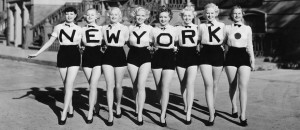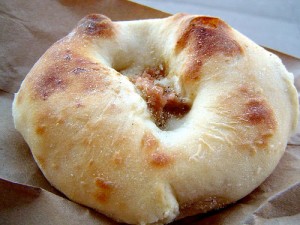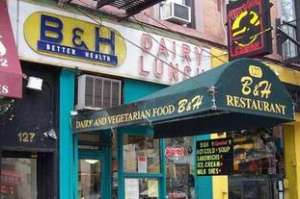February 28th, 2016 § § permalink
Ah, nostalgia. Sentimental memories of yesteryear are bittersweet. HG is nostalgic about the New York HG left many decades ago. Cheap rents on the Upper West Side. Even cheaper rents in Greenwich Village and Chelsea. Mom and Pop stores everywhere. Friendly greetings. Shopkeepers who would always cash a check in the days before ATM’s. All wiped out by the chains and high priced, high rise condos. “Co-op conversions” destroyed the distinguished old apartment houses where artists and intellectuals paid affordable rents. Dining out is a questionable experience (except, of course, at Daughter Victoria’s four restaurants–Rosie’s, Cookshop, Vic’s, Hundred Acres— where her husband, Marc Meyer, is the supervising chef). Everything in most restaurants is fancy, “creative” and centered around kale, small plates and expensive wine. Cheap meals? Fuhgeddabout it!! The Automat with its good coffee and splendid casseroles is gone. So is serviceable Bickford’s. There are still a number of Jewish pastrami heavens. All lousy. Even Katz’s and Carnegie. Sadly, the Jewish “dairy” restaurants are almost all gone, There are a few left. B & H at 127 Second Avenue maintains the old traditions. For those unfamiliar with the term, a Jewish “dairy” restaurant serves fish, vegetables, dairy products. No meat or meat products. The two great New York dairy restaurants were Ratner’s (on Delancey) and Rappaport’s (on Second Avenue). What did they serve? Herring in an infinite variety,. Gefilte fish. Borscht. Schav. Pirogen. Blintzes. Noodles with butter and pot cheese. Scores of smoked fish, tuna and sardine salads. HG is only, scratching the surface. Uptown on the Upper West Side there was the Paramount Famous on W. 72nd Street and the fancy Steinberg’s on Broadway in the 80’s. There were many other good dairy eateries in The Bronx and Brooklyn. All had great bread baskets filled with bagels, bialys, rye bread, challah and pletzels (onion rolls). Gallons of sour cream adorned the tables. Enough. HG is getting tearful.
(SJ here. Please look for a rebuttal to this very good, but highly suspect post tomorrow.)

July 19th, 2013 § § permalink
Many decades ago, HG frequented a colorful bar in Manhattan’s theater district — Harold’s Show Spot. It was a hangout of actors (Ben Gazzara, Anthony Franciosa, Shelley Winters), directors, stage managers, etc. On the walls were sardonic photos and posters celebrating playwrights who had only one play that made it to Broadway — Michael Gazzo (“Hatful of Rain”); Donald Bevan and Ed Trzcinski (“Stalag 17”), etc. The display was known as The Wall of the One Shots. Recently, HG thought about “The Wall” in terms of one shot restaurants that are generally indifferent but do one thing outstandingly well. In New York there was a (name forgotten) French restaurant in the East 30s that was uniformly mediocre except for an outstanding roast pigeon (served rare, of course). El Charro, a trapped-in-amber Spanish/Mexican joint that served (and still serves!) homogenized, bland Mexican food alongside a wonderful, steaming, garlicky pot of shrimp (or scallops) in green sauce. An un-named Cuban sandwich place in Washington Heights that presented a sublime platter of butterflied shrimp, deep fried and accompanied by black beans and rice. Many more. Sauteed fish in tofu skin wrappers at a Chinese restaurant on Chatham Square. Blintzes at Ratner’s and kasha varnishkes at Rappaport’s — two (now-shuttered)Lower East Side standouts. Sturgeon and eggs at Barney Greengrass on the Upper West Side. In Santa Fe, HG orders one dish at Santacafe — perfect fried calamari. In Denver, HG always has succulent roast chicken at Potager and avoids the rest of the menu. In Paris, HG has bouillabaisse at Charlot: Roi des Coquillages (everything else on the carte is indifferent or overpriced.) Grilled pig’s foot with sauce bearnaise (certainly) at Pied de Cochon. And, New Jersey’s Belmont Tavern (located in Belleville) needn’t have a menu at all as it offers only one transcendent, must-travel-to-taste, inimitable dish — Stretch’s Chicken Savoy.

January 30th, 2013 § § permalink
“Comfort” in terms of restaurants is hard to define. There are plenty of neighborhood diners and the like serving up comfort food from meatloaf to frito pie, but for HG, a “comfort” restaurant has to have longevity (restaurant has been around a long time); old fashioned decor; professional waitpersons with long years of service; an unchanging menu. “Comfort” means a democratic approach. No special deference to big shots. No “Siberia.” Gage & Tollner (long closed) in Brooklyn met HG’s “comfort” criteria. So did the two (now closed) “dairy” restaurants on the Lower East Side — Ratner’s and Rappoport’s. As far as places that are still in existence, HG has three favorites. In Boston, it’s Durgin-Park. Very touristy and very plain spoken. HG likes to start with clams on the half shell. Then, a giant slab of rare roast beef (or chicken pot pie or grilled knockwurst with Boston baked beans). For dessert, New England Indian Pudding, natch. In Chicago, nothing beats Gene & Georgetti for old time Windy City flavor. Sirloin steak with a “Garbage” salad and fried onion rings. In San Francisco, Tadich Grill does the best Pacific seafood. HG has one or two Sloe Gin Fizzes at the bar. When seated at table, HG dives into a Dungeness crab cocktail, sauteed Petrale sole or the vast Cioppino, the incomparable seafood stew. A true New York “comfort” restaurant is Keen’s Chop House, home of the famed (giant) mutton chop. However, the prices at Keen’s continue to move upward so the eatery is barely in the “comfort” zone and has instead moved into masochist territory. With the guidance of SJ, HG is comforted at affordable Chinese restaurants in Manhattan, Flushing and the Sunset Park neighborhood of Brooklyn.
But wait…There’s a fourth. And, it truly defines the word “comfort.” Located in Italy, of course. HG refers to Bologna’s wondrous Ristorante Diana. A very old restaurant with a beautiful mirrored interior. Gentle lighting. Helpful (never obsequious) service. HG starts his meals there with a glass of Prosecco while contemplating the delights which will ensue. A bottle of Emilia Romagna’s red Sangiovese is uncorked. Then, a plate of tagliatelle dressed simply with butter and the best Parmigiano Reggiano. Using an instrument designed for the purpose, the waiter showers the pasta with shavings of white truffle. The heady fragrance fills the air and occupants of neighboring tables nod in approval. This is followed (and it is not an anti-climax) by Bollito Misto. For those unfamiliar, this refers to a variety of boiled and poached meats. At Diana, the Bollito Misto is served from a large trolley wheeled by a very large man. On the trolley are two poached sausages, Cotechino and Zampone, plus boiled beef, pork and tongue — all juicy and flavorful. This is accompanied by salsa verde and a pungent mostarda di frutta. Dessert is Semifreddo followed by a number of snifters of grappa (for digestive purposes). A brief stroll and a long nap is obligatory. True Comfort.

February 8th, 2012 § § permalink
HG misses the high caloric New York breakfast treats of yesteryear. Greenberg’s Sticky Schnecken Buns. These honey, nut and cinnamon drenched little guys were more addictive than heroin. Sold by a shop — William Greenberg Jr. Deserts — on Madison Avenue, they were expensive and madly delicious. It took self discipline not to demolish an entire box before they were brought home.  When the effects of weed smoking brought about a passion for sweet goodies, all senses cried out for the Greenberg’s product. Apparently Greenberg’s son is alive and well and making these wonderful buns according to his father’s recipe which are for sale HERE.
When the effects of weed smoking brought about a passion for sweet goodies, all senses cried out for the Greenberg’s product. Apparently Greenberg’s son is alive and well and making these wonderful buns according to his father’s recipe which are for sale HERE.
Croissants from the Sutter bakery on Greenwich Avenue in The Village. Flakey, crisp, outrageously buttery. Much superior to anything in Paris. BSK was partial to slices of Zito’s bread (from the old Bleecker Street bakery which closed in 2004) drenched with honey. With softly scrambled eggs, HG liked buttered Jewish rye or Pechter’s (or Stuhmer’s) pumpernickel (obtainable at Zabar’s).
Sometimes nothing tasted better than a warmed (not toasted) bialy liberally smeared with Daitch’s cream cheese (or Zabar’s scallion cream cheese). HG never fancied bagels. HG is concerned that bialy baking has entered a period of decline (are the old masters dead or basking in Florida sunshine?). Have not had a truly great bialy in years. Sadly, bialys shipped recently by HG’s much loved Russ & Daughters didn’t have that old time oniony zest. (SJ will interject now. The old time great bialy still exists at Kossar’s Bialys on Grand Street. A serious treat when warm from the oven and eaten whole right from a brown paper bag. Says SJ: You wouldn’t order fish from a baker, so don’t order bialys from an appetizing store.)

Possibly the best breakfast treat of all was the “pletzel.” This was a roll covered in baked onions. Good? As my Mom would say: “Nu,nu, don’t ask.” These were on the table at Jewish dairy restaurants like Ratner’s and Rappaport’s on the Lower East Side and at Jewish bakeries throughout The Bronx. Gone, all gone. HG’s eyes grow misty.

An Onion Pletzel
July 3rd, 2011 § § permalink
 Thoughts of ice cold borscht and steamy New York weather make HG recall those refuges from the heat: Dairy restaurants. Dairy restaurants obeyed Jewish dietary laws and served only “dairy” and “pavre” food.
Thoughts of ice cold borscht and steamy New York weather make HG recall those refuges from the heat: Dairy restaurants. Dairy restaurants obeyed Jewish dietary laws and served only “dairy” and “pavre” food.
They served borscht (beet soup), schav (sorrel soup), blintzes (rolled crepes stuffed with cheese or potato) , kasha varnishkes (buckwheat groats with butterfly shaped pasta), potato pirogen (boiled potato and onion dumplings) and more. Big bowls of excellent bread, bialys, onion rolls — also called “pletzels” and copious amounts of butter. Big bowls of thick sour cream were there on the table to accompany every dish. There was fish (considered “parve” a.k.a. neutral meaning neither meat nor dairy) including many varieties of herring; tuna and sardine salads; gefilte fish with strong horse radish.
No meat. Emphatically no meat. Forbidden. A kosher enterprise could not serve both meat and dairy products.
Every Manhattan neighborhood had a Dairy restaurant (okay, not the Upper East Side). The Paradise and Steinberg’s were popular on the West Side. Ratner’s and Rappaport’s ruled the Lower East Side. Scores more in The Bronx and Brooklyn. All gone. Assimilation or changing tastes?
SJ reports only one traditional “Dairy” remains: B&H on Second Avenue. Long may it cool fevered brows and clog arteries.







